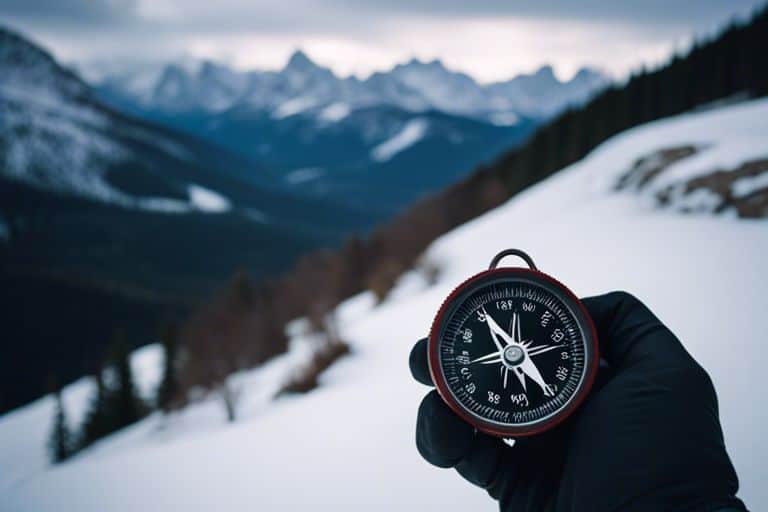Navigating through the wilderness in the wintertime can be daunting, but with the right tools and skills, you can ensure a safe and successful journey. Compass navigation is an essential skill that you should master before embarking on a winter hike. With the unpredictable weather conditions and potential hazards such as deep snow, limited visibility, and icy trails, relying on electronic devices alone can be risky. That’s why understanding how to use a compass effectively can be a lifesaving skill during a winter hike.
When you’re out in the wilderness during winter, relying on GPS and smartphones can be dangerous due to battery life and signal issues. A compass doesn’t rely on batteries or signals, making it a dependable tool for navigation. By knowing how to use a compass and reading maps, you can stay on track and avoid getting lost, even in challenging weather conditions. So, before your next winter hike, make sure to brush up on your compass navigation skills to ensure a safe and rewarding adventure.
Key Takeaways:
- Safety: Compass navigation is crucial for winter hiking as it helps hikers to stay on track and avoid getting lost in snowy and unfamiliar terrain.
- Weather Conditions: Winter weather can be unpredictable, and a compass can help hikers navigate through fog, snow, and low visibility conditions.
- Backup to Technology: In the event of a GPS or electronic device failure, a compass serves as a reliable backup for navigation during winter hikes.
- Route Planning: Compass navigation aids hikers in planning their routes and determining the best path to take in snowy and icy conditions.
- Wilderness Survival: Compass navigation skills are essential for winter hiking as they can be crucial for surviving in case of an emergency or getting stranded in the wilderness.
Understanding Compass Navigation
Now that you understand the importance of compass navigation for winter hiking, it’s time to delve into the basics of how to use a compass effectively. If you’re new to using a compass, it’s essential to familiarize yourself with the fundamentals to ensure your safety and success while navigating in the winter wilderness. A great resource to learn more about map and compass use is available on Reddit’s post on Map & Compass: You need to know how to use them.
Basics of Compass Use
When it comes to compass navigation, understanding the basic functions of your compass is crucial. Familiarize yourself with the different parts of your compass, including the needle, housing, and orienting arrow. Understanding how to read a compass and take accurate bearings will be essential for successful navigation. Remember, a compass can provide you with a sense of direction, but it’s up to you to orient yourself and plot your course effectively.
As you start on your winter hiking journey, keep in mind that the magnetic north may not be the same as the true north due to magnetic declination. This is a critical factor to consider when using your compass for navigation. Learning how to adjust for declination and taking accurate bearings will be essential for a successful winter hiking trip.
Adjusting Techniques for Winter Conditions
Winter conditions can drastically affect the accuracy of your compass navigation. Snow, ice, and extreme cold can impact the functionality of your compass and make navigation more challenging. When using a compass in winter conditions, it’s important to ensure that it is not affected by any metal objects or electronic devices, as these can interfere with its accuracy. Additionally, extreme cold can cause the liquid inside the compass to freeze, affecting its movement.
One technique to overcome these challenges is to keep your compass close to your body to prevent it from freezing and to ensure its accuracy. Furthermore, practicing skills such as triangulation and taking multiple bearings can help you confirm your location and navigate through winter landscapes more effectively. These adjustments are essential for your safety and success in winter hiking.
Equipment for Compass Navigation
Obviously, having the right equipment is crucial for successful compass navigation during winter hiking. Without the proper gear, you could easily get lost, putting yourself in a dangerous situation. In this section, we will discuss the essential equipment you need for compass navigation in winter conditions.
Selecting a Durable and Reliable Compass
When it comes to compass navigation, the most important piece of equipment is, of course, your compass. For winter hiking, it is crucial to select a compass that is durable and reliable. Look for a compass that is specifically designed for cold weather conditions, as extreme temperatures can affect the accuracy of a standard compass. You want a compass that is made of sturdy materials that can withstand the cold, and that has a clear and easy-to-read dial, even in low light conditions. Invest in a high-quality compass that you can trust to lead you in the right direction, no matter the weather.
Maintenance of Navigation Gear in Winter
Another important aspect of equipment for compass navigation in winter is maintaining your gear. Cold temperatures and snow can take a toll on your equipment, so it’s essential to regularly check and maintain your compass and other navigation tools. Make sure your compass is free from any ice or snow buildup that could hinder its accuracy. Keep your gear dry and free from any debris that could affect its performance. Regular maintenance will ensure that your navigation gear remains reliable and ready for use, keeping you safe and on track during your winter hikes.
The Role of Agility and Endurance in Winter Navigation
Lastly, to navigate successfully during winter hiking, you need to understand the importance of agility and endurance. Winter terrain can be unpredictable and demanding, requiring you to be physically prepared to handle the challenges that come your way. Agility and endurance play a crucial role in keeping you safe and ensuring that you can reach your destination without issues.
Developing Physical Stamina for Winter Hiking
Physical stamina is crucial for winter hiking, as you’ll be facing challenging weather conditions, uneven terrain, and carrying heavier gear. To develop the necessary endurance, you should focus on cardiovascular and strength training. Engaging in activities such as running, cycling, and hiking will help improve your cardiovascular fitness, while strength training exercises for your legs, core, and upper body will prepare you for the physical demands of winter hiking. Remember to start with low-impact activities and gradually increase the intensity to avoid injury and build endurance.
Agility Training for Rough Terrain
When navigating through winter terrain, agility is essential for maintaining balance and reacting quickly to changes in the environment. To improve your agility, incorporate exercises like agility ladder drills, cone drills, and plyometric training into your workout routine. These exercises will help you develop the quick reflexes and coordination needed to tackle rough terrain. Additionally, practicing balance-focused activities such as yoga and Pilates can help you build the stability required to navigate icy and uneven surfaces with confidence.
Navigation Strategies for Winter Hiking
Your ability to navigate effectively while winter hiking is essential for your safety and overall enjoyment of the experience. Unpredictable weather conditions, shorter daylight hours, and challenging terrain make navigation a critical skill to master. Here are some key strategies to help you navigate with confidence during your winter hikes.
Offensive and Defensive Tactics in Poor Visibility
In poor visibility, such as during a snowstorm or whiteout conditions, it can be easy to get disoriented and lose your way. Defensive tactics involve taking measures to ensure you stay on course, such as using a GPS device or map and compass to regularly track your progress and confirm your location. Offensive tactics, on the other hand, involve actively seeking out landmarks or other visual cues to stay oriented, such as following a specific set of waypoints or using natural features like ridgelines or tree lines to guide your path.
Remember to stay calm and focused if visibility deteriorates, and be prepared to rely on your navigation tools and skills. In these conditions, even a short distance off course can lead to potentially dangerous consequences, so make sure to constantly assess your surroundings and make adjustments as necessary to stay on track.
Formation Techniques for Group Hiking
When hiking in a group during winter, it’s important to establish a formation that promotes safety and effective navigation. One popular technique is the “arrowhead” formation, where the most experienced navigator leads at the front, with the rest of the group following closely behind in a single file line. This allows for clear communication and ensures that everyone stays on the designated path, particularly in areas with limited visibility or challenging terrain.
Another effective formation is the “leapfrog” method, where two hikers take turns leading the group for a set distance, with the second in line following the leader’s path and constantly communicating with the rest of the group. This technique allows for regular breaks and minimizes the risk of straying off course, as each leader keeps the group focused and on track.
By implementing these formation techniques, you can maximize safety and efficiency during group hikes in winter conditions, while also providing opportunities for less experienced hikers to learn from those with more advanced navigation skills. Always ensure clear communication and adherence to the established formation to avoid potential hazards and maintain a cohesive group dynamic.

The Importance of Innovation in Compass Navigation
To ensure successful winter hiking, it is crucial to understand the importance of innovation in compass navigation. By embracing innovative techniques and technologies, you can enhance your ability to navigate accurately and safely in challenging winter conditions. Innovation in compass navigation not only improves the accuracy and efficiency of your route-finding, but also contributes to your overall safety and enjoyment of the outdoors.
Advancements in Compass Design
Advancements in compass design have revolutionized the way hikers navigate through winter terrain. Modern compasses are equipped with improved accuracy and durability, making them reliable tools for navigation. Additionally, features such as built-in inclinometers, luminous dials, and global needle systems have made compasses more versatile and user-friendly. These advancements empower you to navigate with confidence, even when faced with low visibility or extreme weather conditions.
Integrating Modern Technology with Traditional Skills
Integrating modern technology with traditional compass navigation skills can significantly enhance your winter hiking experience. Global Positioning System (GPS) devices and smartphone applications can provide you with accurate positioning data and detailed topographic maps, complementing the use of a compass. By combining traditional compass navigation techniques with modern technology, you can efficiently navigate through varying landscapes and challenging terrains while mitigating the risk of getting lost or disoriented. It is important, however, to remember that technology can fail in extreme conditions, so it is essential to have a solid foundation in traditional compass navigation skills.
Preparing for the Unexpected: Training and Techniques
After you have familiarized yourself with the use of a compass for navigation in winter hiking, it is important to prepare for the unexpected. This includes training and mastering techniques that will help you stay safe and make informed decisions while out in the wilderness. It’s not just about knowing how to use a compass, but also about being equipped with the knowledge and skills to handle unforeseen challenges.
Scenario Training for Winter Hiking Challenges
One crucial aspect of preparing for the unexpected is scenario training. This involves simulating various winter hiking challenges, such as getting lost, encountering severe weather conditions, or facing an emergency situation. By putting yourself in these scenarios, you can practice using your compass to find your way back to safety or signal for help when needed. This hands-on experience can help you become more confident and capable in real-life situations. Additionally, it allows you to evaluate your decision-making abilities and improve your problem-solving skills in challenging environments.
Essential Survival Skills and First Aid
Equipping yourself with essential survival skills and first aid knowledge is paramount for winter hiking. In addition to compass navigation, you should be proficient in building a shelter, starting a fire in snowy conditions, and finding sources of water and food. You should also have a good understanding of how to provide first aid for cold-related injuries, such as frostbite and hypothermia. These skills can make a difference in extreme situations and could potentially save your life or the lives of others. By mastering these crucial survival skills, you will be well-prepared to handle emergencies and unexpected challenges that may arise during your winter hikes.
Health and Conditioning Considerations
Despite your excitement about winter hiking, it’s crucial to consider the impact cold-weather conditions can have on your health and physical conditioning. Winter hiking requires a higher level of cardiovascular fitness, muscular strength, and endurance. Additionally, cold temperatures can add stress to your body, increasing the risk of injury and illness.
Nutrition and Supplements for Cold-Weather Endurance
When it comes to cold-weather endurance, proper nutrition is essential for sustaining energy levels and maintaining body warmth. You’ll need to consume a balance of carbohydrates, fats, and proteins to fuel your body during a winter hike. Additionally, hydration is key, as cold air can increase fluid loss through respiration. Packing high-energy snacks and warm, calorie-dense meals can help keep your energy levels up throughout your hike.
Recovery and Conditioning to Prevent Injuries
Your body’s ability to recover and condition itself is critical for preventing injuries during winter hikes. The cold weather can make muscles and joints more prone to strains and sprains, so it’s essential to incorporate proper warm-up and cool-down routines into your hiking regimen. Additionally, focusing on strength training, flexibility, and balance exercises can help improve overall conditioning and reduce the risk of injury. Prioritize recovery by allowing for adequate rest between hikes, and consider incorporating activities like yoga or swimming, which can help maintain flexibility and muscle recovery.
FAQ
Q: Why is compass navigation important for winter hiking?
A: Compass navigation is important for winter hiking because snow and ice can obscure trails and landmarks, making it easy to become disoriented. A compass provides a reliable method for finding your way, especially when visibility is limited by snowfall or fog. It is an essential tool for maintaining your bearings and ensuring that you stay on the right path, even in challenging winter conditions.
Q: How does compass navigation help in winter hiking?
A: Compass navigation helps in winter hiking by providing a consistent reference point for determining direction. When trails are covered in snow or ice, and natural landmarks are obscured, a compass can guide hikers along their desired route. It also allows hikers to navigate safely through changing weather conditions, as well as plan and execute their hikes with confidence, regardless of the winter environment’s challenges.
Q: What are the benefits of using a compass for winter hiking?
A: The benefits of using a compass for winter hiking include enhanced safety and confidence in navigation, even when faced with reduced visibility and challenging terrain. A compass is a reliable tool that ensures hikers can stay on course and reach their destination, even in winter conditions. It also provides a sense of independence by reducing reliance on natural landmarks and other external aids, making it an essential component of any winter hiker’s toolkit.



0 Comments